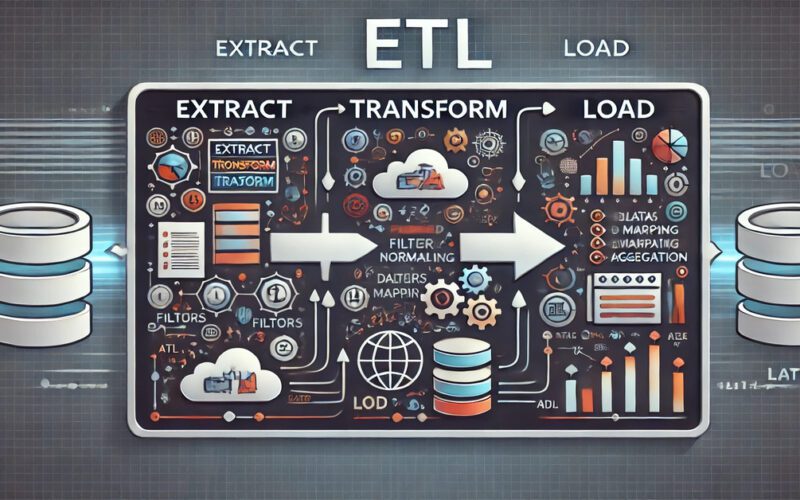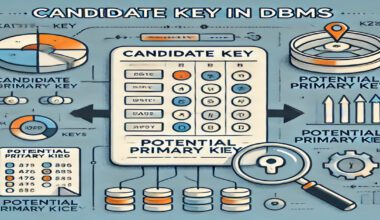Summary: This article explores the significance of ETL Data in Data Management. It highlights key components of the ETL process, best practices for efficiency, and future trends like AI integration and real-time processing, ensuring organisations can leverage their data effectively for strategic decision-making.
Introduction
ETL plays a crucial role in Data Management. This process enables organisations to gather data from various sources, transform it into a usable format, and load it into data warehouses or databases for analysis. Efficient management of ETL Data is essential for businesses seeking to leverage their information for strategic decision-making.
This article explores the key processes involved in ETL and presents best practices for maximising efficiency. It ensures that organisations can harness the full potential of their data while minimising time and resources.
Understanding ETL Data
ETL stands for Extract, Transform, Load and is a crucial Data Management and integration process. It refers to the steps that allow organisations to gather data from various sources, transform it into a suitable format, and load it into a target data repository, such as a data warehouse.
By following this structured approach, businesses can consolidate data from multiple origins, ensuring a unified view for analysis and reporting.
The Role of ETL in Data Warehousing and Analytics
ETL plays a pivotal role in data warehousing and analytics by facilitating the smooth movement of data across different systems. It helps organisations create a central repository where all relevant data resides, allowing easy access and analysis.
ETL processes extract data from disparate sources—such as databases, CRM systems, and flat files—enabling companies to consolidate their information into a single data warehouse. This centralisation supports more effective decision-making, as analysts can easily access and analyse comprehensive datasets.
Moreover, ETL ensures that the data is transformed into a consistent format during the transformation phase. This step is vital for maintaining data integrity and quality. Organisations can derive meaningful insights that drive business strategies by cleaning and enriching the data.
As a result, ETL becomes the backbone of Data Analytics, empowering companies to leverage their data for improved forecasting, trend analysis, and strategic planning.
Key Components of ETL Processes
The ETL process consists of three primary components: extraction, transformation, and loading, each serving a specific purpose. By understanding these key components, organisations can effectively manage and leverage their data for strategic advantage.
Extraction
This is the first stage of the ETL process, where data is collected from various sources. Data extraction can involve pulling information from relational databases, NoSQL databases, APIs, and web services. The goal is to retrieve the required data efficiently without overwhelming the source systems.
Transformation
In this stage, the extracted data undergoes various processes to ensure it meets the quality standards and formats required for analysis. This can include:
- Cleaning (removing duplicates and correcting errors),
- Normalising (standardising formats),
- Aggregating (summarising data), and
- Enriching (adding additional data points).
Loading
The transformed data is loaded into the target destination, such as a data warehouse. Loading can be performed in several ways, including full loads, which refresh the entire dataset, or incremental loads, which only add new or changed data.
This flexibility allows organisations to maintain their data warehouse efficiently while minimising disruptions to ongoing operations.
Best Practices for ETL Efficiency
Maximising efficiency in ETL (Extract, Transform, Load) processes is crucial for organisations seeking to harness the power of data. Implementing best practices can improve performance, reduce costs, and improve data quality. This section outlines key practices focused on automation, monitoring and optimisation, scalability, documentation, and governance.
Automation
Automation plays a pivotal role in streamlining ETL processes, reducing the need for manual intervention, and ensuring consistent data availability. By automating key tasks, organisations can enhance efficiency and accuracy, ultimately improving the quality of their data pipelines.
Scheduling ETL Jobs
Automating ETL jobs is essential for maintaining a consistent data flow. Scheduling jobs at appropriate intervals allows organisations to extract and process data without manual intervention. ETL tools often have scheduling features, enabling users to set up daily, weekly, or real-time jobs.
This automation minimises errors and ensures timely data availability, allowing businesses to respond swiftly to changing needs.
Use of ETL Tools and Platforms
Employing robust ETL tools and platforms can significantly enhance automation. Tools like Apache NiFi, Talend, and Informatica provide user-friendly interfaces for designing workflows, integrating diverse data sources, and executing ETL processes efficiently.
By leveraging these platforms, organisations can automate complex tasks, reduce development time, and enable non-technical users to participate in data preparation. Choosing the right tool based on the organisation’s specific needs, such as data volume and complexity, is vital for optimising ETL efficiency.
Monitoring and Optimisation
Continuous monitoring and optimisation are critical for ensuring ETL processes operate at peak performance. By implementing robust monitoring techniques and optimisation strategies, organisations can quickly identify issues and enhance the overall efficiency of their data workflows.
Performance Monitoring Techniques
Effective monitoring is key to ensuring the smooth functioning of ETL processes. Organisations should implement performance monitoring techniques that track data extraction speeds, transformation times, and loading durations.
Utilising dashboards and alerts can help teams quickly identify performance metrics and trends. Reviewing these metrics enables proactive adjustments to improve efficiency and prevent potential bottlenecks.
Identifying Bottlenecks and Optimisation Strategies
Bottlenecks in ETL processes can severely hinder performance. Common bottlenecks include slow data extraction from sources, inefficient transformations, and lengthy loading times. To optimise ETL, organisations should conduct thorough analyses to identify these issues.
Strategies may involve optimising SQL queries, parallelising tasks, and ensuring data pipelines are designed for efficient processing. Regularly reviewing the entire ETL workflow and seeking feedback from data engineers can uncover areas for improvement.
Scalability
As organisations grow and data volumes increase, scalability becomes vital in designing ETL processes. By focusing on scalable solutions, organisations can ensure that their Data Management systems can handle growth effectively without sacrificing performance.
Designing ETL Processes for Growth
As data volumes increase, designing scalable ETL processes becomes imperative. Organisations should anticipate growth by creating flexible ETL workflows that can handle larger datasets without significant modifications.
Modular design principles allow for easy adjustments and enhancements to existing processes, accommodating new data sources or transformations as business needs evolve. Scalability ensures that ETL systems can grow alongside the organisation’s data demands, maintaining performance and reliability.
Cloud-Based ETL Solutions
Adopting cloud-based ETL solutions offers significant scalability advantages. Platforms like AWS Glue, Google Cloud Dataflow, and Azure Data Factory enable organisations to scale their ETL processes dynamically.
Cloud-based solutions allow businesses to allocate resources based on demand, allowing them to handle peak loads without investing in additional infrastructure. Moreover, these platforms often include built-in tools for monitoring and optimising ETL workflows, further enhancing efficiency.
Documentation and Governance
Robust documentation and governance practices are essential for maintaining the integrity and reliability of ETL processes. Organisations can ensure compliance and uphold data quality throughout the ETL lifecycle by documenting workflows and establishing clear governance protocols.
Importance of Documenting ETL Processes
Documenting ETL processes is essential for maintaining clarity and ensuring compliance. Comprehensive documentation provides a roadmap for Data Engineers, allowing for the smooth onboarding of new team members and reducing knowledge gaps.
Additionally, well-documented processes facilitate troubleshooting and optimisation efforts, enabling teams to identify and rectify issues as they arise quickly. Organisations should adopt standard documentation practices, including data lineage tracking and change logs, to record all ETL processes accurately.
Data Governance Practices
Establishing robust data governance practices is crucial for maintaining data quality and compliance. Organisations should define clear roles and responsibilities for Data Management, ensuring that team members understand their accountability in maintaining ETL processes.
Implementing data quality checks, access controls, and validation rules helps uphold data integrity throughout the ETL lifecycle. Regular audits of ETL processes and data governance practices can ensure compliance with regulations and internal policies, fostering trust in the organisation’s data assets.
By adopting these best practices, organisations can significantly enhance the efficiency of their ETL processes. Automation, effective monitoring, scalability, and robust documentation and governance improve performance and empower teams to leverage data effectively for informed decision-making.
Future Trends in ETL
As data grows in volume and complexity, the ETL (Extract, Transform, Load) landscape evolves rapidly. Emerging technologies and methodologies are reshaping how organisations handle their data, ensuring they remain competitive in a data-driven world.
This section explores the latest trends in ETL, focusing on AI/ML integration and real-time processing. It also makes predictions for the future of ETL processes.
AI and Machine Learning Integration
The integration of Artificial Intelligence (AI) and Machine Learning (ML) into ETL processes is transforming how organisations manage data. AI-powered ETL tools can automate repetitive tasks, such as data cleansing and transformation, significantly reducing the time and effort required for these processes.
Additionally, ML algorithms can analyse historical data patterns to predict potential issues and suggest optimisations, allowing data engineers to address problems proactively before they escalate. This synergy between AI, ML, and ETL enhances efficiency and improves data quality and accuracy.
Real-Time ETL Processing
Another significant trend is the shift towards real-time ETL processing. As businesses increasingly rely on timely data for decision-making, the demand for real-time data integration has surged. Traditional batch processing methods give way to streaming data integration, where data is processed continuously as it is generated.
This approach allows organisations to react swiftly to changing circumstances, improving their agility and responsiveness. Tools and platforms that facilitate real-time ETL are becoming essential for organisations seeking to harness the power of data in real-time analytics and reporting. Looking ahead, several predictions emerge regarding the future of ETL processes:
Increased Automation
The trend towards automation will continue to grow, with more organisations adopting AI-driven ETL tools. These tools will automate data extraction and transformation and implement machine learning algorithms to enhance decision-making processes.
Greater Focus on Data Governance
As data privacy regulations become stricter, organisations will emphasise data governance more in their ETL processes. This will include enhanced data lineage tracking, compliance measures, and transparency in data handling.
Cloud-Based ETL Solutions
The migration to cloud-based data storage and processing will accelerate, with more businesses opting for cloud-native ETL solutions. These solutions offer scalability, flexibility, and cost-effectiveness, making them ideal for handling large volumes of data.
Interoperability and Integration
Future ETL processes will prioritise interoperability between data sources and tools. Organisations will seek to create seamless integration pathways, enabling better collaboration and data sharing across departments.
Closing Statements
Maximising efficiency with ETL Data is essential for organisations striving to leverage their data for strategic decision-making. By understanding the key components of the ETL process—extraction, transformation, and loading—businesses can optimise their Data Management strategies. Implementing best practices such as automation, effective monitoring, scalability, and robust documentation ensures that data remains high-quality and compliant.
Organisations must embrace emerging trends, including AI integration and real-time processing, as the landscape evolves to stay competitive. By focusing on these areas, businesses can fully harness the potential of ETL Data to drive informed decision-making and enhance operational efficiency.
Frequently Asked Questions
What is ETL Data?
ETL Data refers to the process of Extracting, Transforming, and Loading data from various sources into a target repository. It enables organisations to consolidate and analyse data effectively, ensuring a unified view for strategic decision-making and improving overall data quality.
Why is ETL Important for Businesses?
ETL is crucial for businesses as it streamlines Data Management by integrating data from disparate sources. This process enhances data quality, consistency, and accessibility, enabling organisations to make informed decisions based on comprehensive and accurate data insights.
What are the Best Practices for ETL Data Management?
Best practices for ETL Data Management include automating processes, monitoring performance, ensuring scalability, and maintaining thorough documentation. These practices help organisations optimise efficiency, enhance data quality, and ensure compliance, ultimately empowering them to leverage their data effectively.




